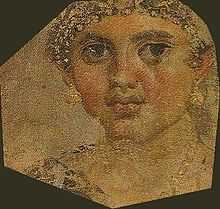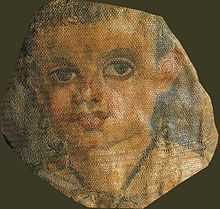Tomb of Aline
The Tomb of Aline is an ancient Egyptian grave from the time of Tiberius or Hadrian, excavated at Hawara in 1892.
Find conditions, finds, date
In the second half of the 19th century, the increasing interest in Egyptian history, culture and art led to a veritable contest between various European nations, all aiming to secure ancient finds of the best possible quality (and quantity) for their national museums. In this general context, the German archaeologist Richard von Kaufmann undertook a short campaign of excavations at Haware in March 1892; his most important find was the so-called Tomb of Aline.[1] A shaft led to a simple mud-brick-lined pit of 2.8 by 3.5 m which contained eight mummies. Three were undecorated, two had paper masks and three were adorned with mummy portraits. The grave had no superstructure.
The three mummies with painted portraits lay at the bottom; they were those of the woman Aline and of two female children. The two masked mummies lay at right angles on top of them; they were those of a man and of a somewhat older girl. The two undecorated mummies, in turn, lay on top, again at right angles. On the mummies of the man, the woman and the three girls, the wrapping had been additionally secured with clay sealings, using different sealstones. One depicted Heracles fighting the Nemean lion, the others heads. Not all sealings are preserved. The gravegoods included a clay pot with a spray of flowers, as is typical for such graves. There was also a roughly hewn stele bearing the following Greek inscription:
| Greek | English |
|---|---|
|
ΑΛΙΝΗΙ
|
Aline |
The grave was named after this inscription. Scholarship assumes that Aline is the woman buried in the tomb and equipped with a mummy portrait. Further, it is believed that the man was her husband and the girls her daughters. As the ages and sexes of the undecorated mummies are not known, they cannot be similarly attributed. The separation of the date in the inscription in two parts, resulting from the insertion of Aline's age in the middle, is unusual. Since it was common in Roman Egypt to count the year from the accession of the current ruler, the grave can be dated, in conjunction with the portrait's hairstyle, quite securely to one of two possible dates. It is usually taken to be from the tenth year of the reign of Tiberius, i.e. 24 AD. The same hairstyle became popular once more a century later, so that the 10th year of Hadrian's reign (AD 107) is also a possibility, but most scholars prefer the earlier date. Further arguments in favour of the later date include the fine painting style and use of hatching, both typical of the 2nd century AD, the lilac tones of the garments, the depiction of the woman as rather well-fed, as well as the hair and beard of the man.[2] It remains unclear when the mummies were deposited and whether all died within the same generation.
Today, the finds from the Grave are at the Egyptian Museum, Berlin. Part of them is on display in the Altes Museum.[3]
Mummy portraits and masks
Aline
_(11554538765).jpg)
The portrait of Aline[4] was painted in tempera on linen, as were those of the two girls. It has a height of 40 cm and a width 32.5 cm. Below the painted cloth, scraps of linen pressed onto the mummy's face were used to provide an even surface, so that the portrait is nearly flat. Some of the portraits were painted before the death of their subject, but in Aline's case, where it is actually painted on the end of the mummy wrapping, it appears to have been produced after death, perhaps based on a previously prepared portrait.[5] As is common for mummy portraits, the painting produces the impression of three-dimensional depth, a relatively recent feature in Egyptian art and due to Graeco-Roman influences. Frontal depictions of human faces had also been unusual throughout most of the history of Egyptian art. The wavy hairstyle with a central parting is painted simply, but carefully. The small ringlets above the forehead are striking. The face appears full, but not fat. It conveys the impression that this woman, who belonged to the middle or upper levels of Egyptian society, had led a good life. Her simple jewellery is carefully painted. The depiction of the necklace made of gilded plaster, added to the portrait. Aline wears a white tunica or chiton, thin lilac bands (clavus) run across her shoulder. The colours are warm. The sad, wistful gaze is typical of mummy portraits. Altogether, it is a masterful portrait of a middle-aged woman.
Aline is one of the exceedingly rare cases where we know the name and appearance of a person from antiquity who did not belong to the ruling classes and is not otherwise known from literature.
Children

The two mummies of the younger girls have not been opened as yet. In the early 1990s they were examined by using modern techniques. The portrait of the older girl, probably the middle one among the three daughters of Aline and her husband, resembles that of her mother. Since it is still attached to her mummy, it is less clearly visible at present; additionally, it has been attached somewhat too far to the right of the window-like opening in the wrapping. As with the other children and the man, her name is unknown. She wears valuable but simple jewellery and has a ringlet hairstyle.

For a long time, scholarship considered the younger girl as a boy. Recent research definitely proves that the chubby-cheeked child with ears sticking out is a girl. Around her neck is a leather band with a lunula pendant, an apotropaic amulet commonly worn by women or girls. Her chiton is violet in colour, a feature exclusive to females. Further it has partially fallen, exposing her left shoulder, an attribute of the goddess Aphrodite, aimed to underline erotic attraction. It is commonly used on the mummy portraits of women and even young girls. Thus, the child's gender is indubitably female.[6]
Paper masks
In contrast to the painted portraits, the paper masks were less concerned with depicting individuals. The mask of the male mummy is gilded. The find of the masks and portraits in the tomb shows that both forms of treating the dead did not only coexist at the same time, but could indeed be used by the same family in a single grave.
Bibliography
- R. Germer/H. Kischkewitz/M. Lüning: Das Grab der Aline und die Untersuchung der darin gefundenen Kindermumien, in: Antike Welt 24 (1993), p. 186-196
- Hannelore Kischkewitz: Mumienporträt der Aline, in Das Ägyptische Museum Berlin, van Zabern, Mainz, p. 106 ISBN 3-8053-1184-2
- Barbara Borg: "Der zierlichste Anblick der Welt …". Ägyptische Porträtmumien, Mainz 1998 (Zaberns Bildbände zur Archäologie) p. 17-20 ISBN 3-8053-1742-5
- Rose-Marie Hagen/Rainer Hagen: Ägyptische Kunst, Taschen, Köln u.a. 2007, p. 94f. ISBN 978-3-8228-5455-6
See also
- Fayum mummy portraits
- Panel painting
- Ancient Roman art
References
- ↑ Details on the find, see Barbara Borg: "Der zierlichste Anblick der Welt …". Ägyptische Porträtmumien, Mainz 1998, p. 17-20
- ↑ Supporting the later date: Barbara Borg, „Der zierlichste Anblick der Welt …“ Ägyptische Porträtmumien, Mainz 1998, p. 20
- ↑ Inventory numbers: portrait of Aline: 11411; mummy of the middle daughter 11412; mummy of the youngest daughter: 11413; paper mask of the man: 11414
- ↑ SDescription follows Hagen/Hagen: Ägyptische Kunst, Taschen, Köln u.a. 2007, p. 94; Hannelore Kischkewitz: Mumienporträt der Aline, in Das Ägyptische Museum Berlin, von Zabern, Mainz, p. 106
- ↑ Hannelore Kischkewitz: Mumienporträt der Aline, in Das Ägyptische Museum Berlin, van Zabern, Mainz, p. 106
- ↑ Barbara Borg: „Der zierlichste Anblick der Welt …“ Ägyptische Porträtmumien, Mainz 1998, p. 20, description of fig. 23